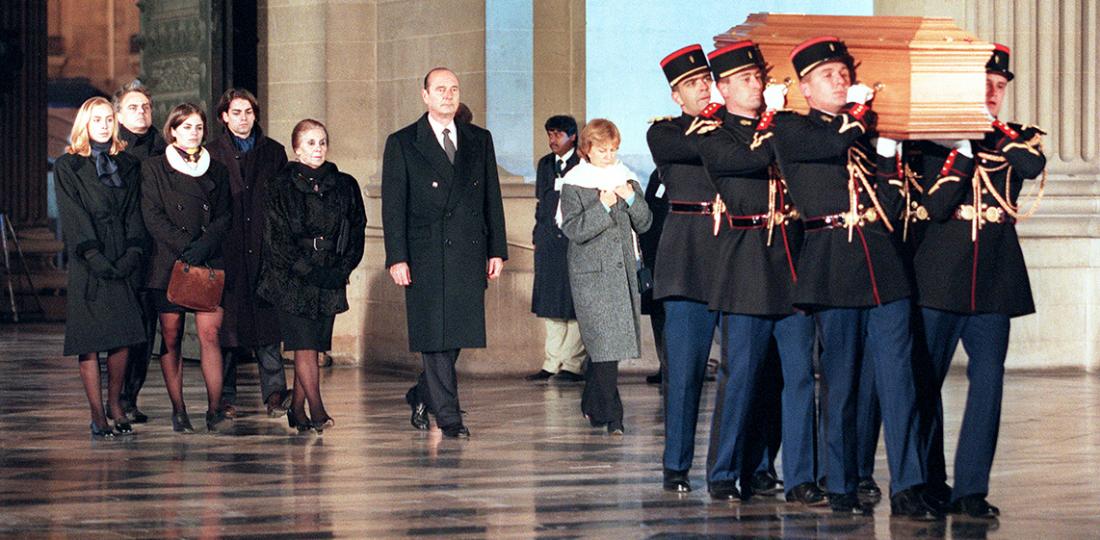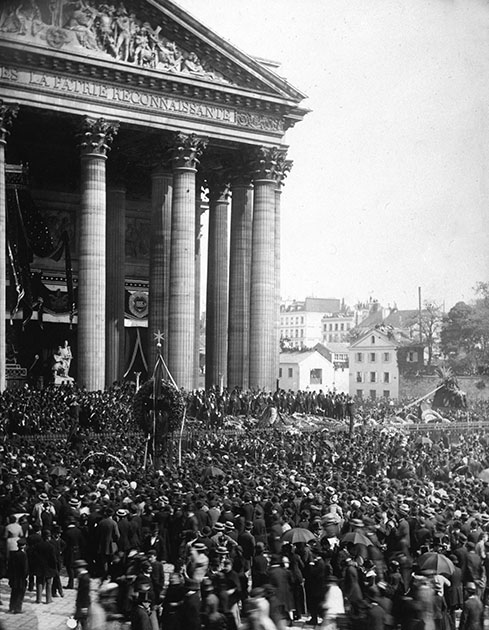Commemorating writers, a republican rite

Following the admission of Alexandre Dumas to the Pantheon in 2012, there is talk of another writer, Maurice Genevoix, being admitted to this republican temple. This choice recalls the central place of writers in the formation of republican culture, and could be an opportunity to question the way in which politics honours their memory.
In an article of 1919, Lucien Descaves deplored how many commemorative monuments were being built for writers, preferring them to have streets named after them: “When I look up at a small street sign and make out a name dear to my heart and my mind (...), I am lost in a daydream for half an hour (...)” (L. Descaves, in Le Figaro, 11 May 1909 – see full list of references at the end of this issue). The power of suggestion he lent these signs seems to have been short-lived, however, as some names are no longer familiar except to specialists, just like many busts and statues in public places. However, the protest movements concerned with national memory which, since the events of Charlottesville, have targeted certain statues, have given back these commemorative forms their full political significance, drawing attention to the fact that honouring national historical figures in public places is a cultural practice that is still very much alive and kicking. Among these personalities, France venerates its writers in a quite distinctive way (see the map of these monuments at monumentslitteraires.com). Very present in street names, they occupy a special place on commemorative plaques (28% of Parisian plaques: see A. Dautriat, Sur les murs de Paris, 1999) and public statuary (18% of statues outside Paris: see J. Lalouette, in Centenaires, jubilés, commémorations, 2019), the best represented being those that combined a literary career with a political career. Meanwhile, 15% of national commemorations in 2017 concerned literature, and more than 16% in 2018. This proportion drops only in the Pantheon (less than 8% of those buried there), but that is without counting the commemoration in absentia of those buried elsewhere, like Aimé Césaire, or the 757 who died for France – writers in the broadest sense – honoured by two collective plaques (1927 and 1949). Why do we commemorate these writers? (Few women are granted this privilege.) Is it a case of aesthetic recognition, or is it first and foremost a political gesture? To shed light on the meaning of these commemorations, it is worth remembering that there are no givens in such a process, and the eternity aspired to by stone monuments does not detract from the spirited debates that preceded their installation.
Commemorations under discussion
A sign of recognition and belonging to a shared culture, commemoration is used either to unite around a figure of universal popularity, or to accept a marginal or divisive figure into the canon, by designating them as heritage worthy of being passed on and preserved. It is proper to any rite of heritage designation. In this sense, it works constantly at the frontier between consensus and controversy. Neither civil society nor the institutions responsible for national commemorations avoid these disputes over legitimacy, which surround the ceremonies when the events being commemorated are not altogether in the past. Back when the culture of commemoration was beginning to take shape, in particular between the Franco-Prussian War and the First World War, some ceremonies prompted rioting, like the unveiling of the statue of Renan, in Tréguier in 1903 (M. Gasnier, in Cahiers de l’Association internationale des études françaises, 2010), or else lively debate, like the admission of Zola to the Pantheon, debated in the French parliament in 1908 (A. Pagès, in Zola au Panthéon 1908-2008, 2008; Zola au Panthéon. L’épilogue de l’affaire Dreyfus, ed. A. Pagès, 2010). On the other hand, the margins of national memory are filled with figures seeking the commemorative limelight. Some choose to champion these rejects, such as the Société du Souvenir Littéraire, particularly active in the early 20th century, whose explicit purpose was to “celebrate the memory of writers not remembered by any official ceremony”. Writers constitute a special case in national memory, insofar as commemorations seek, on occasion, to win over universal approval by attempting to separate the man from the work, to consider only the latter. Two anniversaries caused a stir for that reason at the Haut Comité aux Commémorations Nationales (successor to the Délégation aux Célébrations Nationales, founded in 1974): the anniversary of the death of Céline in 2011, cancelled at the last minute, and that of the birth of Charles Maurras in 2018, which was withdrawn from the list of “commemorative anniversaries”, leading to the resignations of ten of the 12 members of the Haut Comité. These two events, which followed a period of reformulation of anniversaries as national commemorations, shed light on an issue that any official remembrance body with a historical mission is liable to come up against, requiring neutrality in remembrance policy, by its very nature political.

Crowds gather on Rue Soufflot, Paris, for the funeral of Victor Hugo, 1 June 1885. © Louis Antonin Neurdein/Maisons de Victor Hugo/Roger-Viollet
Transformations of the image of power and the image of the writer
Rather than proof of legitimacy, commemorations are a tool of (re)legitimation both for their object and – due to the reciprocity of the appropriation – for their officiator. The place assigned by the ceremony to the person being commemorated is inversely proportional to the commemorator’s need for legitimation. In the case of writers, given the history of proximity and conflict between the literary and political spheres, the context is of the utmost importance. When writers are celebrated by their peers, the tributes are often kept within the aesthetic domain, even if it means rewriting literary history. But when writers and artists are celebrated in the political sphere, it is the image of power and nationhood that can be transformed. Thus, in the 1910s, many were put to the service of belligerent rhetoric, in spite of themselves. Chateaubriand and Lamartine were celebrated as heroes supposed to unify against the German threat, while La Fontaine and the classics served the assertion of a French spirit of refinement in contrast to the brutality of the enemy (Mathilde Labbé, in Narrations auctoriales dans l’espace public, C. Bisenius-Penin and J. Glesener (eds.), Questions de communication, 2020). In the case of politically engaged writers, such an appropriation might instead involve a depoliticisation of their works or a blurring of political boundaries. Thus, André Malraux’s admission to the Pantheon by Jacques Chirac in 1995 was part of an attempt to “overcome (…) the left/right divide” (Patrick Garcia, in Sociétés & Représentations, 2001). Similarly, the celebration of Aimé Césaire at the Pantheon in 2011 seems to have been intended to alter the presidential image after Article 2 of the Law of 23 February 2005 on the “positive role of the French overseas presence” – the revoking of which was supported by Césaire – and Nicolas Sarkozy’s 2007 Dakar speech, while deliberately diminishing the significance of his political writings to focus on his poetry alone. The image of writers was transformed by the 2007 elections, which dispensed with their participation, targeting voters rather than readers.
Admitting Maurice Genevoix to the Pantheon
Inherent to the construction of republican culture, the celebration of writers is a rite which contributes to defining what the Nation expects of its “great men”. The announcement of Maurice Genevoix’s admission to the Pantheon therefore follows on from a founding tradition. Without prejudging future ceremonies, the idea of remembering this great war writer at the same time as those about whom he wrote establishes a connection between the enterprise of collective tributes to the dead of the two world wars and the patriotic use of literature. Originally conceived as a conclusion to the First World War commemorations, this initiative underlines the role of literature in the creation of a collective consciousness. It remains to be seen whether, in the current context, it will be possible to develop the commemoration of writers: this would require a discussion about how the relationship between the literary and the political is formalised in their works, as well as about the fact that, by appropriating the writer and their works for political ends, commemorations risk destroying the very thing they draw from them: literature’s capacity for abstraction from the century’s conflicts, to achieve universality.

